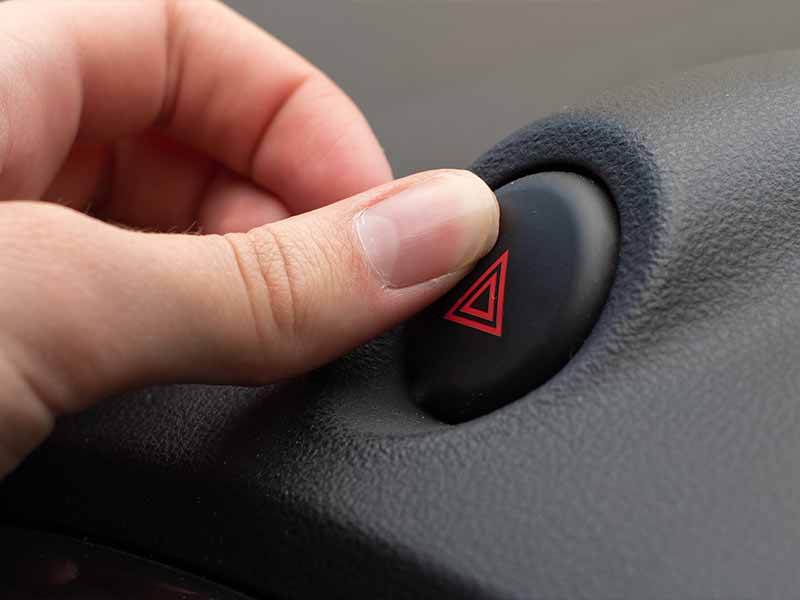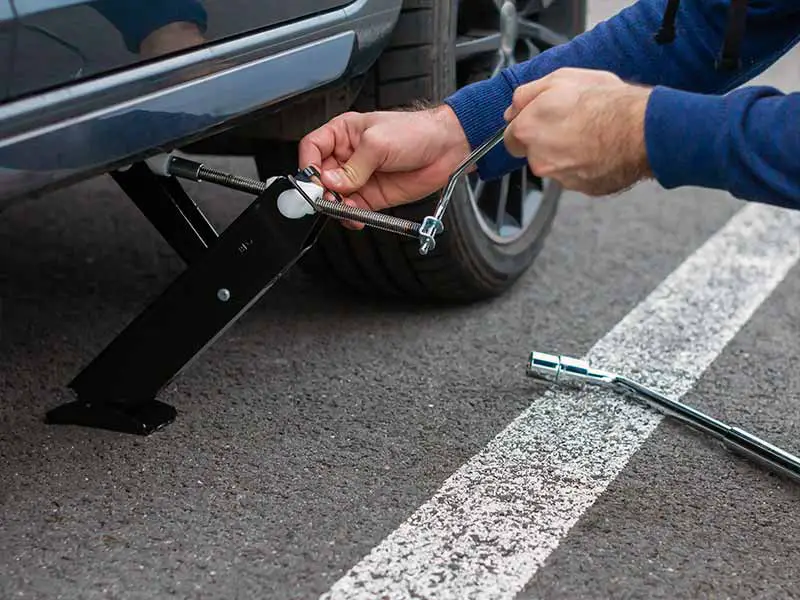Knowing how to change a flat tire is an important skill for every driver. Flat tires can happen for many reasons, like a nail on the road, a sharp rock, or high-speed pothole hit. Being able to change your tire quickly and safely can save you time, money, and stress.
How To Change A Tire
After changing the tire, check spare tire pressure, store flat tire, and tools, and know spare tire limits.
- Gather tools: spare tire, jack, lug wrench, wheel chocks
- Find a safe location, turn on hazard lights, apply parking brake
- Slightly loosen lug nuts with lug wrench
- Raise vehicle using jack
- Remove lug nuts and flat tire
- Install spare tire and align with wheel studs
- Hand-tighten lug nuts
- Partially lower vehicle, tighten lug nuts with lug wrench
- Lower car completely, remove jack, check lug nuts
In this article, we’ll guide you through the tools you need, the safety steps to follow, the step-by-step process of changing a tire, and what to do after you’ve finished.
Let’s take a closer look.

Modern Spare offers aftermarket spare tire kits for cars and trucks that didn’t come with one from the factory
Tools And Equipment You Need
Before you begin changing a tire, make sure you have all the tools and things you need. Here’s a list of items:
Spare Tire
You need a spare tire that is filled with air and ready to use. Check your spare tire often to make sure it’s in good shape and has enough air.
Jack
A car jack is used to lift your vehicle up so you can take off the flat tire and put on the spare. Make sure the jack can hold your car’s weight and size.
Lug Wrench
This tool helps you loosen and tighten the nuts that hold the tire in place. Most cars come with a lug wrench that fits their tire nuts.
Wheel Chocks
These are used to stop your car from rolling while you change the tire. They may not come with your car or truck but they are important for safety.
Extra Items That Can Help
Gloves
Wearing gloves keeps your hands clean and helps you grip tools better.
Flashlight
A flashlight or headlamp makes it easier to see when changing a tire in the dark.
Tire Pressure Gauge
This tool helps you check if your spare tire has the right amount of air before you put it on.
Make sure you have all these tools and items ready before you change your tire. It’s also a good idea to know where they are in your car, like in the trunk or under the back storage area.

Safety Steps To Follow
Changing a tire can be easy if you follow the correct safety steps. Here’s what you should do:
Find A Safe Spot
If you have a flat tire, slowly drive to a safe place where you can change it. This might be a parking lot or the side of the road with a wide shoulder. Don’t change your tire in the middle of the road or somewhere unsafe.
Turn On Your Hazard Lights
Turn on your car’s hazard lights when you find a safe spot. This tells other drivers that you need help or that they should be careful when passing by.
Use The Parking Brake
Before you start changing the tire, put on the parking brake. This helps keep your car from moving while you’re working on it.
Put Wheel Chocks In Place
Wheel chocks stop your car from rolling. If you have them, put them behind or in front of the tires that are on the ground. This helps keep your car or truck stable and safe.
You can change your tire without any problems by following these safety steps. Remember, staying safe while working on your vehicle is important.
Step-By-Step Guide To Changing A Tire
Follow these steps to change your tire easily and safely:
Step 1: Loosen The lug Nuts
Using your lug wrench, turn the nuts on the flat tire counterclockwise. Loosen them a little, but don’t take them off yet. Just make them easier to remove later.
Step 2: Raise The Vehicle With The Jack
Look in your car’s manual to find the right spot for the jack. Put the jack under that spot and pump the handle until the vehicle is high enough. Make sure there’s enough room to remove the flat tire and put on the spare.
Step 3: Remove The Lug Nuts And Flat Tire
Now, use your lug wrench to take off the lug nuts completely. Keep them in a safe place, so you don’t lose them. Carefully pull the flat tire off the car and set it aside.
Step 4: Put On The Spare Tire
Line up the holes in the spare tire with the bolts on the car. Slide the spare tire onto the bolts, making sure it’s on straight and secure.
Step 5: Hand-Tighten The Lug Nuts
Put the lug nuts back on by hand, turning them clockwise. Tighten them as much as you can using just your fingers.
Step 6: Lower The Car A Bit And Tighten The Lug Nuts
Use the jack to lower the car just enough so the spare tire is touching the ground but the car’s weight isn’t fully on it. Use the lug wrench to tighten the lug nuts even more. Make sure they’re on tight but don’t use too much force.
Step 7: Lower The Car All The Way And Remove The Jack
Take the jack out from under the car and put it away. Carefully lower the car the rest of the way using the jack. Check the lug nuts one more time to make sure they’re tight.
Now you’ve successfully changed your tire! Make sure you follow the next steps to finish up and stay safe on the road.
Craftsman V20 Inflator – Portable Air Compressor
What To Do After Changing The Tire
After you’ve changed the tire, there are a few more things you should do:
Check The Spare Tire’s Air Pressure
Use your tire pressure gauge to make sure the spare tire has enough air. If it’s low, drive slowly to the nearest gas station or repair shop to add more air.
Put Away The Flat Tire And Tools
Store the flat tire, jack, lug wrench, and any other tools you used in your trunk or the right storage area in your car. Make sure they’re secure, so they don’t move around while you’re driving.
Know The Limits Of Your Spare Tire
If you have a temporary spare tire (a “donut”), remember it’s not made for long drives or high speeds. Check your car’s manual or the tire’s label for the maximum speed and distance you can drive with it. Plan to get your flat tire fixed or replaced as soon as you can.
By following these tips, you’ll stay safe on the road and be ready to handle any future tire problems.
Resources
Below are some links you may find helpful when learning about tires
Final Thoughts
Learning how to change a tire is an essential skill for all drivers. Following the steps and safety precautions outlined in this article, you can confidently handle a flat tire and get back on the road quickly.
Remember to regularly check your spare tire’s condition and air pressure, and always keep your tire-changing tools in your vehicle. It’s also a good idea to practice changing a tire in a safe environment, so you’ll be prepared if you ever need to do it for real.
Good luck and happy motoring.





